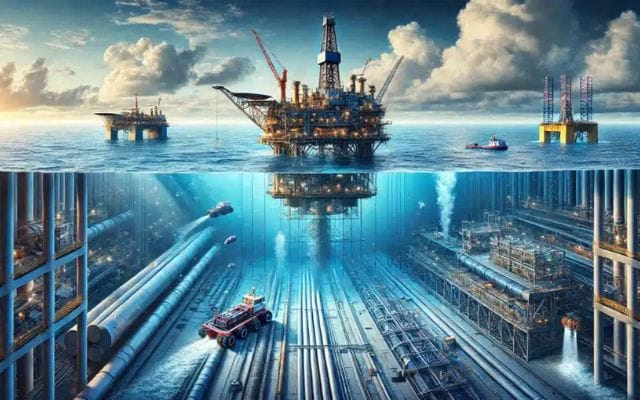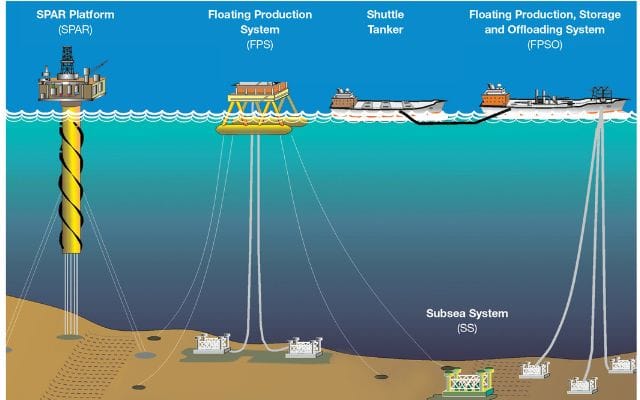
deep offshore technology
Deep offshore technology is revolutionizing how we explore and extract resources beneath the ocean’s surface. As global energy demands rise, so does the need for innovative solutions to access untapped reserves hidden in challenging environments. From advanced drilling techniques to sophisticated floating platforms, deep offshore technology pushes the boundaries of engineering and science.
But what exactly is deep offshore technology? How does it function in some of the harshest conditions on Earth? This article dives into these questions while uncovering its advantages, components, and significance in the oil and gas industry, as well as challenges faced by this transformative field. Join us as we navigate through recent advancements and glimpse into a future where deep offshore technology continues to play a critical role in meeting our energy needs.
What is Deep Offshore Technology?
Deep offshore technology refers to the sophisticated methods and tools used for exploring and extracting resources from the depths of oceans and seas. It encompasses a range of engineering practices designed to operate in extreme underwater environments, where traditional technologies may fall short.
This technology primarily focuses on accessing oil and natural gas reserves located at significant depths, often exceeding 1,500 meters below sea level. The need for DOT stems from increasing global energy demands coupled with declining onshore reserves.
Innovative solutions such as subsea drilling systems, remotely operated vehicles (ROVs), and floating production storage units (FPSUs) define this field. With advancements in materials science and robotics, deep offshore technology continues to evolve, pushing the limits of what’s achievable beneath the waves.
How does Deep Offshore Technology Work?

Deep Offshore Technology operates in some of the most challenging environments on Earth. Its primary goal is to extract valuable resources from beneath the sea floor.
The process begins with advanced drilling rigs designed for extreme depths and harsh conditions. These rigs are equipped with cutting-edge tools that allow engineers to reach oil and gas reserves deep beneath the ocean surface.
Once a suitable site is identified, underwater robots or remotely operated vehicles (ROVs) may be deployed. These machines help inspect potential drilling locations, ensuring safety before any activity begins.
After confirming the site’s viability, subsea systems come into play. They transport extracted hydrocarbons through pipelines directly to processing facilities onshore or aboard floating production units (FPUs).
Continuous monitoring ensures operational efficiency while minimizing environmental impact. Data from sensors attached to equipment allows real-time adjustments during extraction processes, adapting swiftly to changing underwater conditions.
Advantages of using Deep Offshore Technology
Deep Offshore Technology offers numerous advantages that significantly benefit the oil and gas sector. One of the primary benefits is access to untapped resources. Many reserves lie beneath deep waters, often untouched due to previous technological limitations.
Another advantage is enhanced efficiency in extraction processes. Advanced drilling techniques minimize downtime and maximize output, allowing companies to meet rising energy demands effectively. This technology also reduces operational costs over time by optimizing resource management.
Safety improvements are another key aspect. With state-of-the-art equipment and monitoring systems, risks associated with offshore drilling can be mitigated more effectively than ever before.
Moreover, Deep Offshore Technology supports environmental sustainability initiatives by employing methods that limit ecological disruption during extraction activities. Emphasizing cleaner operations helps in maintaining a balance between energy needs and environmental responsibility.
The ability to innovate continuously keeps this sector competitive while meeting global energy challenges head-on.
Major Components of Deep Offshore Technology
Deep Offshore Technology comprises several critical components that work in harmony to facilitate exploration and extraction beneath the ocean’s surface.
One of the primary elements is subsea production systems, which include various underwater equipment designed for drilling, processing, and transporting hydrocarbons. These systems enhance operational efficiency while reducing environmental impact.
Another vital component is the floating production storage and offloading units (FPSOs). These versatile vessels serve as offshore facilities where oil is processed before being transported to shore.
Advanced remotely operated vehicles (ROVs) play a crucial role in inspection and maintenance tasks at great depths. Equipped with cameras and robotic arms, ROVs can navigate challenging underwater environments with precision.
Sophisticated monitoring technology ensures real-time data collection on pressure, temperature, and flow rates. This information drives informed decision-making throughout the extraction process. Each component contributes uniquely to the success of Deep Offshore Technology operations.
The Significance of Deep Offshore Technology in the Oil and Gas Industry

Deep Offshore Technology plays a crucial role in the oil and gas sector. It opens up new avenues for exploration, tapping into resources that were once deemed unreachable.
As onshore reserves dwindle, offshore locations are becoming increasingly vital. This technology allows companies to access deep-sea deposits with precision and efficiency.
The ability to drill in extreme conditions offers significant advantages. Enhanced extraction methods lead to higher yield rates, ensuring energy demands are met sustainably.
Moreover, DOT promotes innovation within the industry. Cutting-edge tools and techniques drive advancements not just in drilling but also in safety measures and environmental protection.
Deep Offshore Technology is reshaping how we approach resource management at sea. Its impact resonates throughout economic sectors while addressing global energy needs.
Challenges and Risks Associated with DOT
Deep Offshore Technology (DOT) presents several challenges that companies must navigate. One major risk is the extreme environment of deep-sea operations. High pressures and low temperatures can lead to equipment failure, posing significant safety risks.
Another challenge involves logistics. Transporting personnel and materials to remote offshore sites requires careful planning and execution. Weather conditions can further complicate these efforts, causing delays or hazardous situations.
Additionally, regulatory hurdles exist as governments impose strict guidelines for environmental protection. Compliance with these regulations can be costly and time-consuming, impacting project timelines.
Human factors cannot be overlooked either. Skilled labor shortages in specialized areas create obstacles in operation efficiency and safety standards.
The potential for oil spills or other ecological disasters looms large over DOT projects, raising concerns about corporate responsibility and public perception. These factors make it essential for companies to approach Deep Offshore Technology with caution and preparedness.
Recent Technological Advancements in Deep Offshore Technology
Recent advancements in Deep Offshore Technology are transforming the landscape of exploration and extraction. Innovations like autonomous underwater vehicles (AUVs) enhance survey capabilities, allowing for detailed mapping of seabeds that were once unattainable.
Machine learning algorithms now play a critical role in data analysis. They help predict equipment failures before they occur, significantly reducing downtime and maintenance costs.
Additionally, advancements in materials science have led to stronger, lightweight composites that can withstand extreme underwater conditions. These materials improve the durability and efficiency of drilling rigs and subsea infrastructure.
Digital twins are also making waves. By creating virtual replicas of physical systems, operators can simulate scenarios to optimize performance without risking any real-world consequences.
These technologies not only increase safety but also support sustainable practices by minimizing environmental impact during operations at sea.
Future Scope and Potential of DOT

The future of Deep Offshore Technology (DOT) is poised for remarkable evolution. As global energy demands surge, innovations in this field can unlock previously inaccessible resources.
Advancements in robotics and automation will enhance operational efficiency. These technologies can reduce human risk while increasing productivity on deep-sea rigs.
Sustainability is becoming a focal point as well. Integrating renewable energy sources with traditional offshore operations could lead to cleaner extraction processes, aligning with environmental goals.
Moreover, data analytics and artificial intelligence are set to revolutionize exploration techniques. Enhanced predictive models will enable companies to make informed decisions quickly.
Collaboration among industry leaders and governments will drive research initiatives that push the boundaries of what’s possible underwater. This synergy promises breakthroughs that could redefine the oil and gas landscape for generations to come.
Conclusion:
Deep Offshore Technology is revolutionizing the oil and gas industry. Its capabilities enable exploration in previously unreachable depths. This innovation drives efficiency, safety, and sustainability.
As new challenges arise, DOT continues to evolve. Emerging technologies promise even greater advancements in drilling techniques and environmental protections.
The synergy of engineering excellence and technological prowess ensures a bright future for offshore operations. Industries are eager to adopt these innovations for long-term success.
In this dynamic landscape, collaboration among stakeholders will be essential. Research institutions, companies, and governments must work together to address complex issues.
Deep Offshore Technology stands as a beacon of progress in resource extraction. It embodies the spirit of innovation while aiming to meet global energy demands responsibly.
FAQ:
What is marine and offshore technology?
Deep Offshore Technology (DOT) represents a significant advancement in the extraction of natural resources from beneath the ocean’s depths. As oil and gas reserves become harder to reach, DOT has emerged as a vital solution for energy companies seeking to tap into these valuable resources.
At its core, Deep Offshore Technology involves sophisticated engineering techniques designed to explore and extract hydrocarbons located deep underwater. This technology utilizes advanced equipment such as subsea drilling systems, floating production units, and remotely operated vehicles (ROVs). Each component plays a crucial role in ensuring efficient operation under extreme conditions.
The advantages of utilizing DOT are substantial. It allows access to untapped reservoirs that traditional methods simply cannot reach. Additionally, it can lead to reduced environmental impact when compared with onshore drilling practices due to improved safety measures and technologies. These benefits make DOT an appealing option for energy companies aiming for sustainability while meeting global demand.
However, navigating the challenges associated with Deep Offshore Technology is also paramount. Harsh weather conditions, deep-sea pressure, and logistical complexities pose risks that must be carefully managed through innovative solutions and robust planning processes.
Recent technological advancements have paved the way for greater efficiency in operations. Innovations like digital twins virtual replicas of physical assets are helping operators monitor performance in real time while predicting maintenance needs before issues arise.
The future scope of Deep Offshore Technology looks promising as exploration expands further into uncharted territories of our oceans. With continuous improvements on one hand and growing concerns about climate change on the other; balancing resource extraction with environmental stewardship will shape this field moving forward.
Marine technology encompasses various aspects related to exploring and utilizing marine environments effectively and offshore technology specifically focuses on operations conducted away from shorelines or coastal zones primarily involving sea-based structures such as oil rigs or wind farms.






